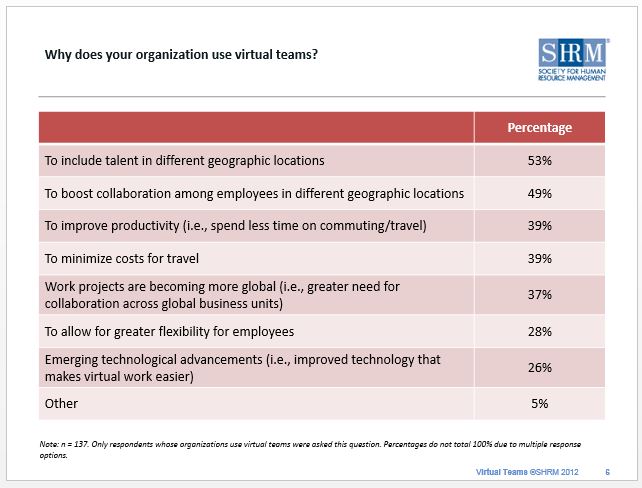| مشخصات مقاله پاورپوینت انگلیسی | |
| عنوان فارسی مقاله | یافته SHRM نظر سنجی: تیم های مجازی |
| عنوان انگلیسی مقاله | SHRM Survey Findings: Virtual Teams |
| فرمت مقاله | پاورپوینت (PPT یا PPTX) |
| تعداد اسلایدها | 20 اسلاید |
| قابلیت ویرایش | دارد |
| قابلیت پرینت | دارد |
| رشته های مرتبط با این مقاله | مهندسی کامپیوتر و علوم اجتماعی |
| گرایش های مرتبط با این مقاله | مدیریت فناوری اطلاعات و اینترنت و شبکه های گسترده |
| کد محصول | EP274 |
دانلود رایگان پاورپوینت انگلیسی سفارش ترجمه این پاورپوینت
| تصویری از مقاله |
 |
| فهرست مطالب |
|
SHRM Survey Findings: Virtual Teams |
| بخشی از مقاله |
|
Key Findings Are organizations using virtual teams? Almost one-half of organizations (46%) use virtual teams in their workplace. Organizations with multinational operations are more than twice as likely (66%) to use virtual teams compared with organizations with U.S.-based operations (28%). Why do organizations use virtual teams? Of organizations that use virtual teams, approximately one-half use them to include talent in different geographic locations (53%) and to boost collaboration among employees in different geographic locations (49%). Other reasons for using virtual teams include improving productivity (39%), minimizing costs for travel (39%), and collaborating more across global business units because work projects are becoming more global (37%). What are the most successful teamwork behaviors resulting from the use of virtual teams? Nearly three-quarters of organizations (72%) indicated that brainstorming solutions for problems or issues was the most successful behavior for virtual teams, followed by setting goals for team initiatives or projects (68%) and developing plans for team initiatives or projects (63%). What are the obstacles that prevent virtual teams from being successful? About one-half of organizations reported that building team relations (51%) and time differences (49%) were the top challenges for successful virtual teams. Organizations also indicated that additional challenges to using virtual teams were distribution of work (32%), differences in cultural norms (26%) and leadership of these types of teams (25%). |
دانلود رایگان پاورپوینت انگلیسی سفارش ترجمه این پاورپوینت